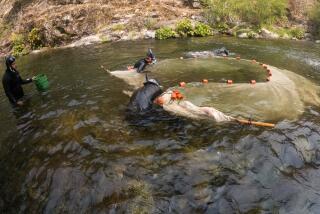Kalamazoo River Is Freshening Up
- Share via
ALLEGAN, Mich. — The Kalamazoo River has almost always been a part of WJ Love’s life.
Some stretches are widely considered among Michigan’s most scenic waterways. Plants and animals abound, and the water runs clear. It’s not unusual to see herons, swans, turtles, grouse, pheasant or even eagles.
But it hasn’t always been that way.
When 71-year-old Love was a boy, the river was filthy, turned a whitish-brown color by upstream paper mills in and around Kalamazoo. He didn’t dare eat the bass, carp and salmon that he caught.
As for the canoe trips he often took as a young man in the early 1960s, he and his companions had one rule: “We were sure whenever we put in or put out that we didn’t put our feet into the water.”
The river is much cleaner now, mostly because of stricter federal guidelines for industrial discharges and wastewater treatment enacted in the late 1960s and ‘70s. But it is by no means pollution-free.
Health officials have advised since 1976 against eating fish caught in the river. Toxic chemicals discharged half a century ago still contaminate the bed, banks and floodplains.
The federal government says factories are responsible for tens of thousands of pounds of polychlorinated biphenyls, or PCBs, that contaminate sediment starting from Morrow Lake Dam near Galesburg, just east of Kalamazoo, to the river mouth at Lake Michigan in Saugatuck.
The U.S. Environmental Protection Agency is developing a cleanup plan, although the problems have been well-documented since the 1950s.
The Kalamazoo River gained national attention when the Oct. 5, 1953, issue of Life magazine ran a photograph of a massive fish kill on a creek that empties into the river where Allegan Dam forms Lake Allegan. The photo caption read, “Four Acres of Carp Corpses on the Kalamazoo.”
Paper companies were blamed for dumping excessive amounts of organic waste into the river. The discharges sapped the stream of oxygen and drove the carp up the tributary, Dumont Creek, where they became trapped and died.
The resulting outcry brought about the earliest efforts to clean the Kalamazoo, although it would not begin in earnest until the mid-1960s.
“The fumes from the river and the dead fish, in some cases, peeled the paint right off the houses there,” said John Pahl, official historian of Allegan and Allegan County.
Love, a retired engineering consultant from Allegan Township, said he was serving a two-year hitch in the Navy in the mid-1950s when a sulfuric acid spill in the river turned his parents’ Allegan home from white to yellow.
He also recalls, as a youth, seeing foamy discharges “maybe the size of automobiles” floating downstream and watching polluted plumes empty into Lake Michigan.
“The river, in the past, was just a dumping place,” said Lisa Sutterfield, Allegan’s city manager.
Within the last two decades, her city of 5,000 has beautified its downtown riverfront by constructing a boardwalk and installing fountains in the river. Not all longtime residents are impressed.
“The people who have lived here all their lives -- those who are 40ish or 50ish -- and grew up with the river stinking and contaminated, sometimes they still consider it that way,” although their perceptions may finally be changing, said Sutterfield, who is 35 and has lived in Allegan for eight years.
“But there are people who’ve only been here the last 15 or 20 years who think it is a real asset to the city.”
PCBs pose the biggest threat to wildlife along the river and to people who -- against the advice of state government -- eat fish taken from water downstream from the city of Kalamazoo.
Love simply wants the river cleaned up enough for the state to remove the fish advisories.
“I’d like to see the river come back to being a good stream to fish out of,” he said. “I would like to go back and fish the thing again if it were clean.”
More to Read
Sign up for Essential California
The most important California stories and recommendations in your inbox every morning.
You may occasionally receive promotional content from the Los Angeles Times.













